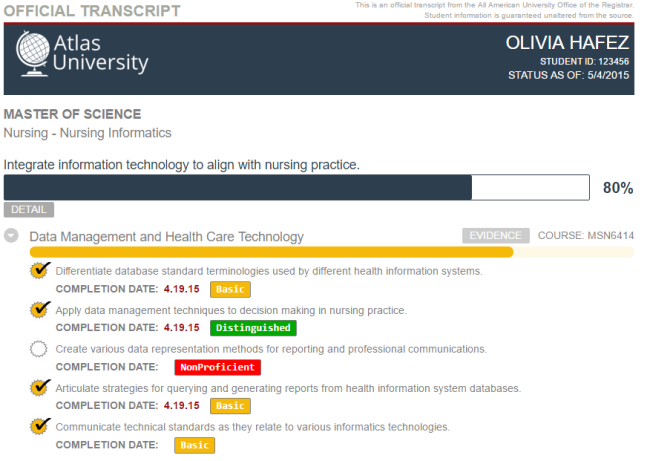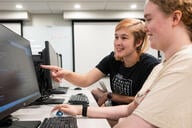You have /5 articles left.
Sign up for a free account or log in.

A mock-up of an extended transcript
UMUC
The University of Maryland University College will this fall pilot a digital “extended transcript.” For now, a prototype offers a look at one institution’s idea of the transcript of the future.
UMUC is one of a dozen colleges involved in the Comprehensive Student Record Project, a partnership between the American Association of Collegiate Registrars and Admissions Officers (AACRAO) and NASPA: Student Affairs Administrators in Higher Education to advance different methods of tracking students’ academic progress. The project, which launched last year, is funded by a $1.27 million grant from Lumina Foundation.
“We have a document right now that doesn’t get a lot of screen time,” Joellen Shendy, associate vice provost and registrar at UMUC, said in an interview. “What we’re hoping to do is to build something that matters more, that goes far deeper into what a student knows, can do and has demonstrated.”
It’s an idea that’s growing in popularity at colleges experimenting with competency-based education, serving working adults or examining how to give students easier access to their records. In addition to (or perhaps in the future, instead of) giving those students a traditional transcript that shows their grades and how many hours they spent studying specific topics, colleges could offer a digital-first document that automatically pulls in students’ papers, projects and other assignments and how they count as progress toward clearly defined learning outcomes. And like a résumé, students could customize it, tailoring how their academic accomplishments are displayed in response to individual job listings.
UMUC’s visual prototype, a mock-up, already checks some of those boxes. At a macro level, it shows how a student pursuing a master’s degree in nursing informatics is progressing toward five program objectives, including “Optimize workflow to maximize the impact of nursing informatics” and “Integrate concepts of meaningful use into nursing informatics practice.” The transcript uses progress bars to show how far along students are toward mastering those objectives.
Clicking on an objective reveals a series of related competencies, and each competency breaks down into one or more skills. Under “Data Management and Health Care Technology,” for example, a student is expected to know how to apply data management techniques to decision making, communicate technical standards and create data representation methods. The transcript tracks students’ level of proficiency -- nonproficient, basic or distinguished -- and the date they gained those skills.
For more information about how students’ course work applies to the competencies, someone viewing the transcript can click on a button labeled “Evidence” to see examples of student work.
“This starts to shift us to an environment where the student has much more agency,” Shendy said. “Right now we have a dead transcript.”
In the future, Shendy said, students may be able to use their transcripts to better understand how the courses they take affect their career prospects. And by giving students the ability to customize parts of their transcripts, UMUC hopes students will be able to show how courses outside their majors and activities outside the classroom apply to their overall education objectives.
“It would behoove us to get rid of the assumption that one transcript rules all,” Shendy said.
More Than Transcripts
UMUC is one of the participants farthest along with its project, said Thomas C. Green, associate executive director at AACRAO. In addition to UMUC’s work, Green said, the Comprehensive Student Record Project is developing in two main directions: documenting nonclassroom activity and increasing access to records.
Elon University is continuing development on its Experiences Transcript, which shows student involvement in extracurricular activities such as interning, service and study abroad. The university is working on a digital version of that transcript, which Green said resembles “a large infographic.”
Stanford University, meanwhile, has a series of projects in the works intended to give students more ways to access information about their time at the institution. Examples include MyLocker, which gives alumni access to their records, and electronic transcripts that are digitally signed by the university to guarantee their authenticity.
Since those and other initiatives were under way before they became a part of the Comprehensive Student Record Project, the entire effort has the backing of a variety of commercial vendors. Stanford has worked with the electronic transcript provider Parchment, for example, while UMUC's partners include Accreditrust, which authenticates digital credentials, and the recent Cengage acquisition Learning Objects.
In a statement, Jon Mott, chief learning officer at Learning Objects, said the company is looking forward to building the next version of UMUC's extended transcript. "We believe that this new, capability-centered (rather than activity-centered) learning record will transform the way students think about and track their achievements and how they represent them to potential employers,” he said.
Elon, Stanford, UMUC and the other participating institutions will report their results later this year. UMUC, for example, plans to pilot a working model of its extended transcript among its M.B.A. students starting this October, Shendy said. While the university has already built a prototype, there are structural issues that need to be resolved before the digital transcript can replace the print version.
Most important is the issue of data. In theory, Shendy said, the transcript will automatically pull in data from other platforms on campus, such as the learning management and student information systems. At the moment, however, many platforms collect and report data in different ways (though efforts are under way to standardize it).
“They’re housing data in a lot of different places,” Green said. “Getting the data to be in one place for every student so that you can make it into whatever you might is one of the biggest challenges we’re seeing in that project.”
After the institutions participating in the effort have completed their pilots, the plan calls for them promote the projects more broadly to see how other colleges and universities outside the project respond to the ideas.
“The concept here is that we don’t think there’s going to be one model that will emerge quickly,” Green said in an interview. “We’re just trying to accelerate the beginning of this.”




